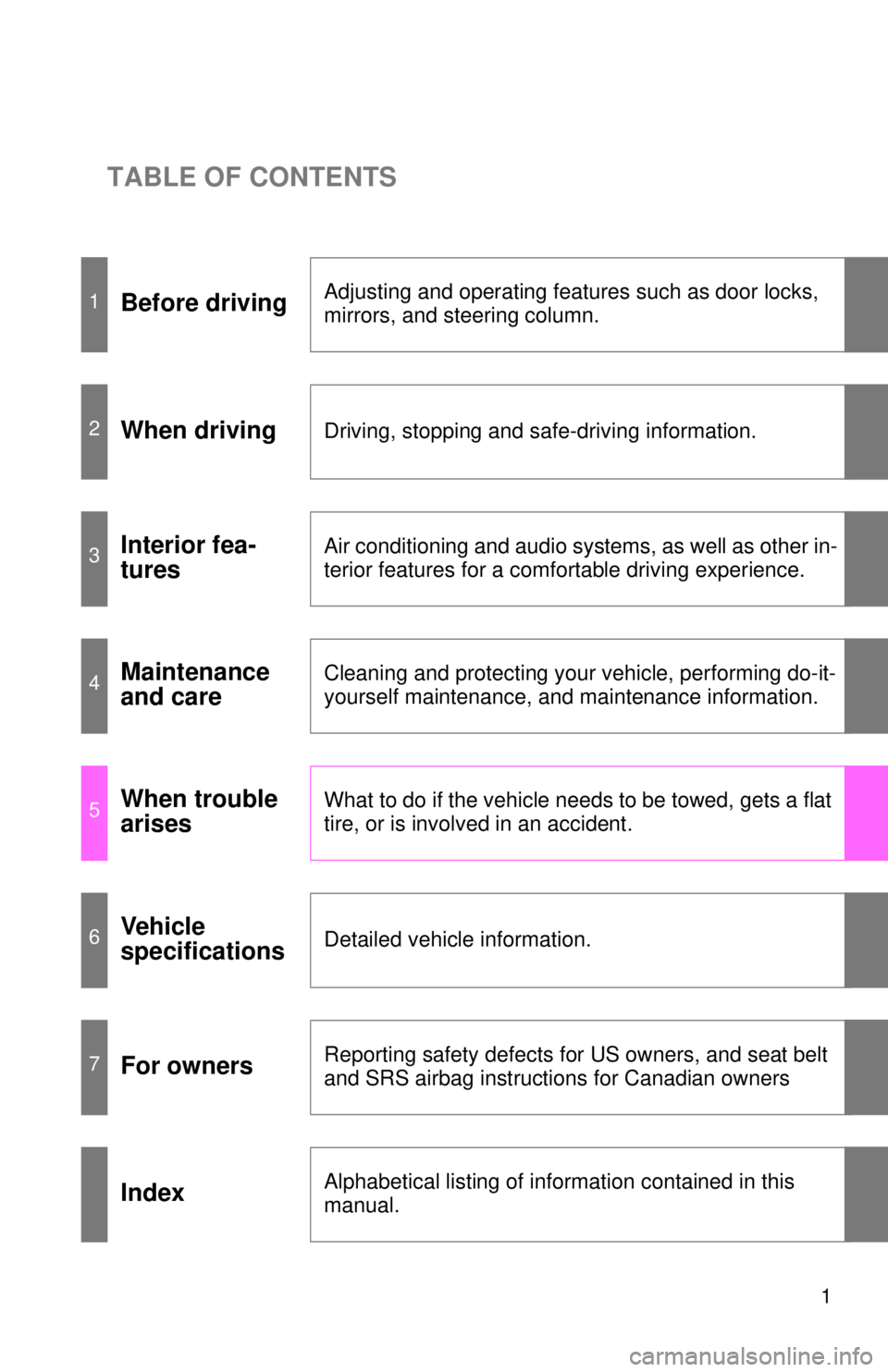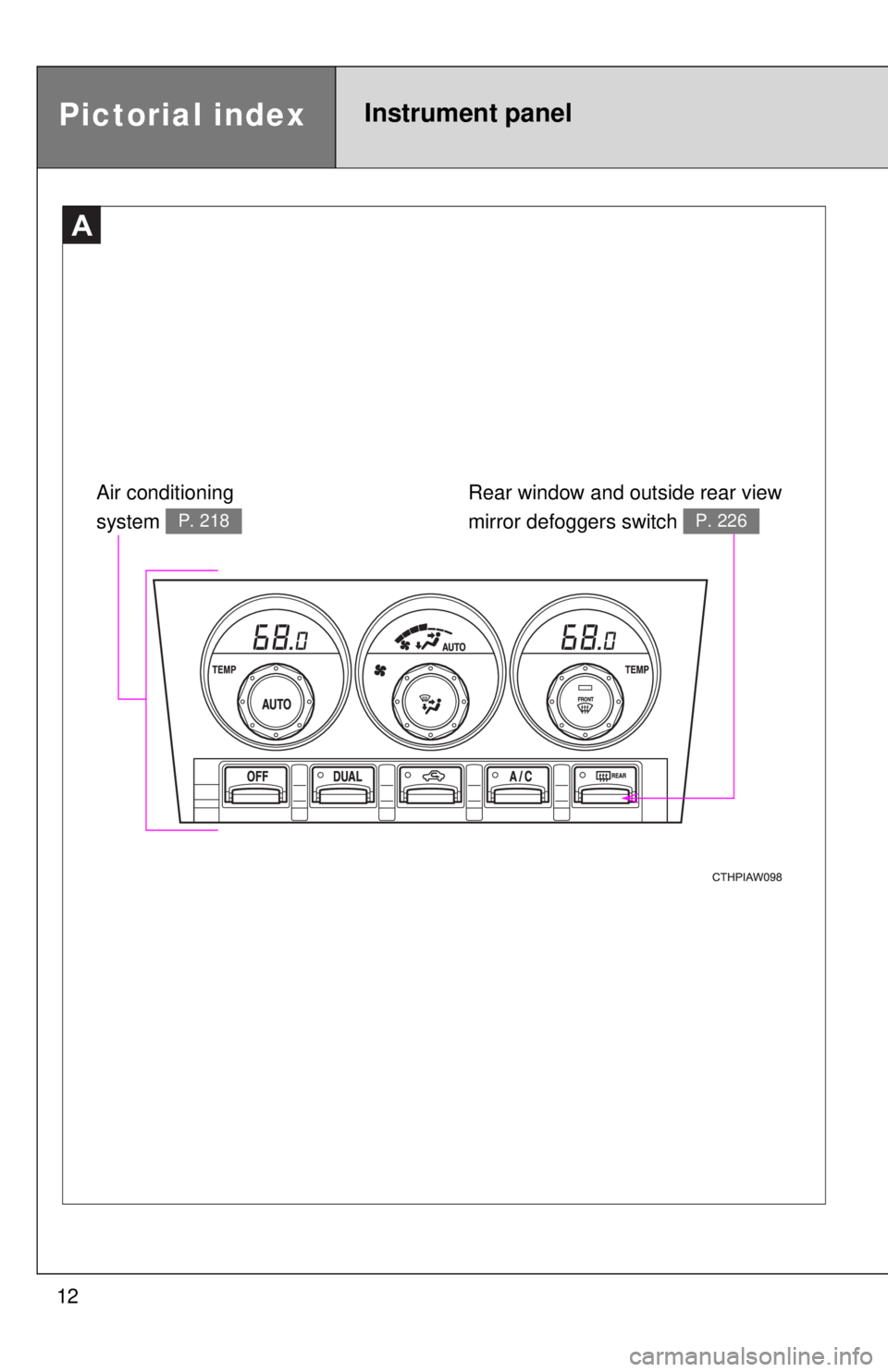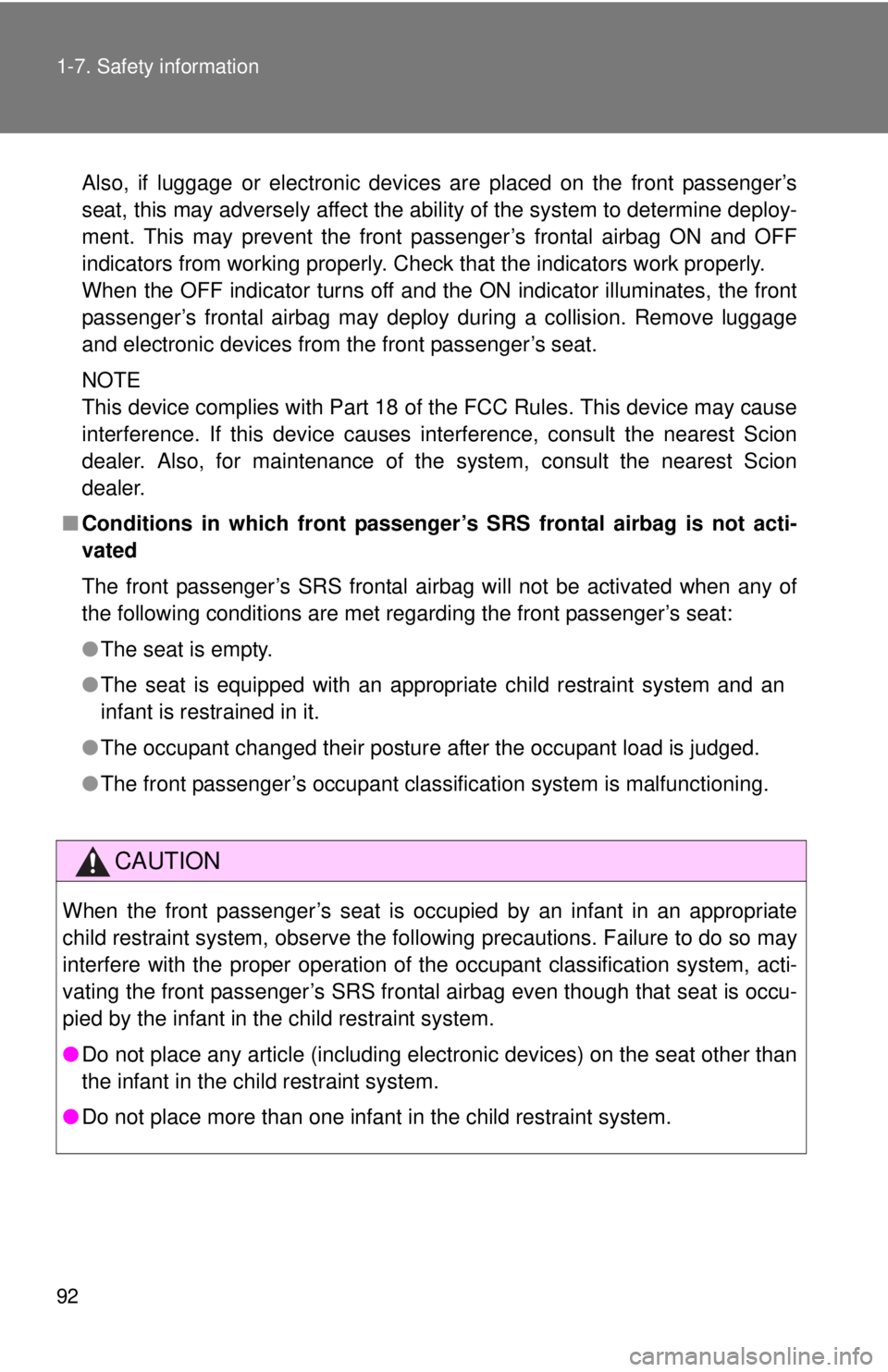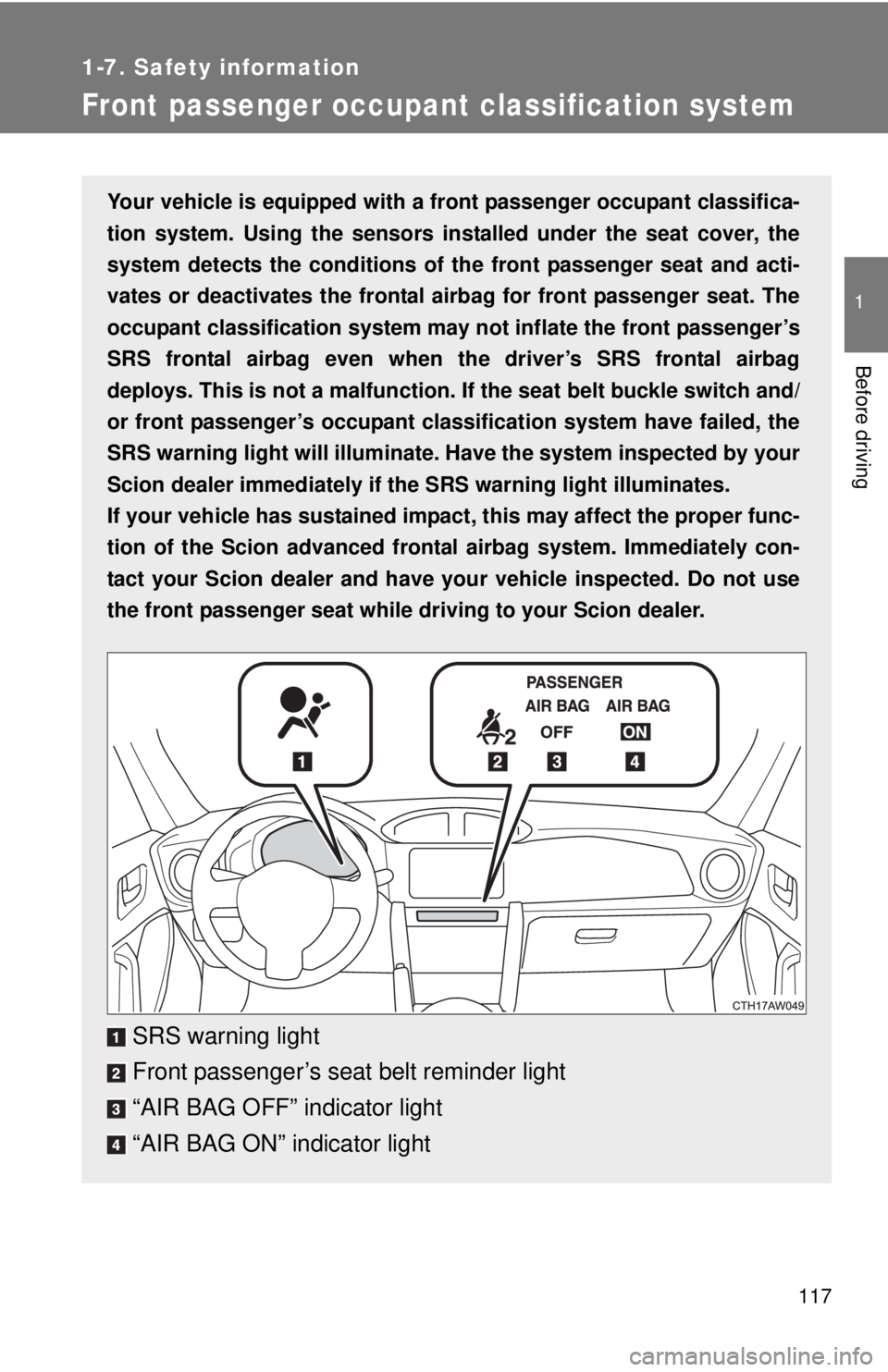air condition TOYOTA FR-S 2014 Owners Manual (in English)
[x] Cancel search | Manufacturer: TOYOTA, Model Year: 2014, Model line: FR-S, Model: TOYOTA FR-S 2014Pages: 452, PDF Size: 5.61 MB
Page 1 of 452

TABLE OF CONTENTS
1
1Before drivingAdjusting and operating features such as door locks,
mirrors, and steering column.
2When drivingDriving, stopping and safe-driving information.
3Interior fea-
turesAir conditioning and audio systems, as well as other in-
terior features for a comfortable driving experience.
4Maintenance
and careCleaning and protecting your vehicle, performing do-it-
yourself maintenance, and maintenance information.
5When trouble
arisesWhat to do if the vehicle needs to be towed, gets a flat
tire, or is involved in an accident.
6Vehicle
specificationsDetailed vehicle information.
7For ownersReporting safety defects for US owners, and seat belt
and SRS airbag instructions for Canadian owners
IndexAlphabetical listing of information contained in this
manual.
Page 3 of 452

1
2
3
4
5
6
7
3
2-3. Operating the lights and windshield wipers
Headlight switch .................. 188
Windshield wipers and washer .............................. 193
2-4. Using other driving systems
Cruise control ...................... 196
Driving assist systems ........ 201
2-5. Driving information Cargo and luggage ............. 207
Vehicle load limits ............... 211
Winter driving tips ............... 212
Trailer towing ...................... 215
Dinghy towing ..................... 216
3-1. Using the air conditioning system and defogger
Automatic air conditioning system .............................. 218
Rear window and outside rear view mirror
defoggers .......................... 226
3-2. Using the audio system Using the AUX/USB port ..... 228 3-3. Using the interior lights
Interior lights list ................. 229
• Interior light ...................... 230
3-4. Using the storage features List of storage features ....... 231
• Glove box ......................... 232
• Bottle holders ................... 233
• Cup holders/console tray ...................... 234
3-5. Other interior features Sun visors........................... 236
Vanity mirrors ..................... 237
Clock .................................. 238
Outside temperature display .............................. 239
Power outlets...................... 240
Seat heaters ....................... 242
Floor mat ............................ 244
4-1. Maintenance and care Cleaning and protecting the vehicle exterior ........... 248
Cleaning and protecting the vehicle interior ............ 252
Cleaning and protecting the Alcantara
® area.......... 256
3Interior features
4Maintenance and care
Page 4 of 452

TABLE OF CONTENTSIndex
4
4-2. MaintenanceMaintenance requirements .................... 258
General maintenance ......... 260
Emission inspection and maintenance (I/M)
programs .......................... 263
4-3. Do-it-yourself maintenance
Do-it-yourself service precautions ...................... 264
Hood................................... 267
Positioning a floor jack ....... 269
Engine compartment .......... 271
Tires ................................... 284
Tire inflation pressure......... 291
Wheels ............................... 295
Air conditioning filter ........... 298
Electronic key battery ......... 300
Checking and replacing fuses ................................ 302
Light bulbs .......................... 310
5-1. Essential information Emergency flashers ........... 322
If your vehicle needs to be towed .......................... 323
If you think something is wrong ............................... 331
Fuel pump shut off system .............................. 332 5-2. Steps to take in an
emergency
If a warning light turns on or a warning buzzer
sounds... .......................... 333
If you have a flat tire ........... 346
If the engine will not start .................................. 357
If the shift lever cannot be shifted from P ................... 360
If you lose your keys ........... 361
If the electronic key does not operate properly ......... 362
If the battery is discharged ........................ 366
If your vehicle overheats..... 370
If the vehicle becomes stuck ................................. 373
If your vehicle has to be stopped in an
emergency........................ 375
6-1. Specifications Maintenance data (fuel, oil level, etc.) ........... 378
Fuel information .................. 390
Tire information................... 394
6-2. Customization Customizable features ........ 407
5When trouble arises
6Vehicle specifications
Page 12 of 452

12
A
Pictorial indexInstrument panel
Air conditioning
system
P. 218
Rear window and outside rear view
mirror defoggers switch
P. 226
Page 30 of 452

30 1-2. Opening, closing and locking the doors and trunk
■Conditions affecting operation
The smart key system uses weak radio waves. In the following situations,
the communication between the electronic key and the vehicle may be
affected, preventing the smart key system, wireless remote control and
engine immobilizer system from operating properly.
(Way of coping P. 362)
● When the electronic key battery is depleted
● Near a TV tower, electric power plant, gas station, radio station, large dis-
play, airport or other facility that generates strong radio waves or electri-
cal noise
● When the electronic key is in contact with, or is covered by the following
metallic objects
• Cards to which aluminum foil is attached
• Cigarette boxes that have aluminum foil inside
• Metallic wallets or bags
• Coins
• Hand warmers made of metal
• Media such as CDs and DVDs
● When other wireless keys (that emit radio waves) are being used nearby
● When carrying the electronic key together with the following devices that
emit radio waves
• A portable radio, cellular phone, cordless phone or other wireless com-
munication device
• Another vehicle's electronic key or a wireless key that emits radio waves
• Personal computers or personal digital assistants (PDAs)
• Digital audio players
• Portable game systems
● If window tint with a metallic content or metallic objects are attached to
the rear window
● When the electronic key is placed near a battery charger or electronic
devices
Page 92 of 452

92 1-7. Safety information
Also, if luggage or electronic devices are placed on the front passenger’s
seat, this may adversely affect the ability of the system to determine deploy-
ment. This may prevent the front passenger’s frontal airbag ON and OFF
indicators from working properly. Check that the indicators work properly.
When the OFF indicator turns off and the ON indicator illuminates, the front
passenger’s frontal airbag may deploy during a collision. Remove luggage
and electronic devices from the front passenger’s seat.
NOTE
This device complies with Part 18 of the FCC Rules. This device may cause
interference. If this device causes interference, consult the nearest Scion
dealer. Also, for maintenance of the system, consult the nearest Scion
dealer.
■ Conditions in which front passenger’ s SRS frontal airbag is not acti-
vated
The front passenger’s SRS frontal airbag will not be activated when any of
the following conditions are met regarding the front passenger’s seat:
● The seat is empty.
● The seat is equipped with an appropriate child restraint system and an
infant is restrained in it.
● The occupant changed their posture after the occupant load is judged.
● The front passenger’s occupant classification system is malfunctioning.
CAUTION
When the front passenger’s seat is occupied by an infant in an appropriate
child restraint system, observe the following precautions. Failure to do so may
interfere with the proper operation of the occupant classification system, acti-
vating the front passenger’s SRS frontal airbag even though that seat is occu-
pied by the infant in the child restraint system.
●Do not place any article (including electronic devices) on the seat other than
the infant in the child restraint system.
● Do not place more than one infant in the child restraint system.
Page 94 of 452

94 1-7. Safety information
●Ensure that no article is placed on the seat other than the occupant.
If the ON indicator still remains illuminated while the OFF indicator tu\
rns off
despite the fact that the actions noted above have been taken, seat the
child/small adult in the rear seat and immediately contact your Scion dealer
for an inspection. Even if the system has passed the dealer inspection, it is
recommended that on subsequent trips the child/small adult always take the
rear seat.
Children who have outgrown a child restraint system should always wear the
seat belt irrespective of whether the airbag is deactivated or activated.
■ Conditions in which front passenger’ s SRS frontal airbag is activated
The front passenger’s SRS frontal airbag will be activated for deployment
upon impact when any of the following conditions are met regarding the front
passenger’s seat.
● When the seat is occupied by an adult.
● When a certain item(s) (e.g. jug of water) is placed on the seat.
Page 97 of 452

97
1-7. Safety information
1
Before driving
The SRS airbag can function only when the “ENGINE START STOP” switch
is in IGNITION ON mode.
The Scion advanced frontal airbag system is designed to determine the acti-
vation or deactivation condition of the front passenger’s SRS frontal airbag
depending on the characteristic of the item(s) or person on the front passen-
ger’s seat monitored by the front passenger’s occupant classification system
sensor. For this reason, only the driver’s SRS frontal airbag may deploy in
the event of a collision, but this does not mean failure of the system.
If the front sub sensors and the impact sensors in the airbag control module
detect a predetermined amount of force during a frontal collision, the control
module sends signals to the airbag modu
le(s) (only driver’s module or both
driver’s and front passenger’s modules) instructing the module(s) to inflate
the SRS frontal airbag(s).
The driver’s and front passenger’s SRS frontal airbags use dual stage infla-
tors. The two inflators of each airbag are triggered either sequentially or
simultaneously, depending on the severity of impact, in the case of the
driver’s SRS frontal airbag and depending on the severity of impact and the
characteristic of the item(s) or person on the seat in the case of the front
passenger’s SRS frontal airbag.
After deployment, the SRS airbag immediately starts to deflate so that the
driver’s vision is not obstructed. The time required from detecting impact to
the deflation of the SRS airbag after deployment is shorter than the blink of
an eye.
Both when only the driver’s SRS frontal airbag deploys and the driver’s and
front passenger’s SRS frontal airbags deploy, the driver’s and front passen-
ger’s seat belt pretensioners operate at the same time.
Although it is highly unlikely that the SRS airbag would activate in a non-
accident situation, should it occur, the SRS airbag will deflate quickly, not
obscuring vision and will not interfere with the driver's ability to maintain con-
trol of the vehicle.
When the SRS airbag deploys, a sudden, fairly loud inflation noise will be
heard and some smoke will be released. These occurrences are a normal
result of the deployment. This smoke does not indicate a fire in the vehicle.
Page 116 of 452

116 1-7. Safety information
●Curtain shield airbag module (left-hand side)
● Satellite safing sensor (under the center of the rear seats)
● Seat belt pretensioner (driver’s side)
● Seat belt pretensioner (front passenger’s side)
● Seat belt buckle switch (front passenger’s side)
● Front passenger’s occupant cl assification system sensor
● Front passenger’s occupant detection control module
● Front passenger’s frontal airbag ON and OFF indicator
● All related wiring
CAUTION
■SRS warning light
If the warning light exhibits any of the following conditions, there may be a
malfunction in the seat belt pretensioners, SRS airbag system and/or front
passenger occupant classification system. Immediately take your vehicle to
your nearest Scion dealer to have the system checked. Unless checked and
properly repaired, the seat belt pretensioners, SRS airbag and/or front pas-
senger occupant classification system will not operate properly in the event
of a collision, which may increase the risk of death or serious injury.
●Flashing or flickering of the warning light
● No illumination of the warning light when the “ENGINE START STOP”
switch is first turned to IGNITION ON mode.
● Continuous illumination of the warning light
● Illumination of the warning light while driving
Page 117 of 452

117
1
1-7. Safety information
Before driving
Front passenger occupant classification system
Your vehicle is equipped with a front passenger occupant classifica-
tion system. Using the sensors inst alled under the seat cover, the
system detects the conditions of the front passenger seat and acti-
vates or deactivates the frontal ai rbag for front passenger seat. The
occupant classification system may not inflate the front passenger’s
SRS frontal airbag even when th e driver’s SRS frontal airbag
deploys. This is not a malfunction. If the seat belt buckle switch and/
or front passenger’s occupant cl assification system have failed, the
SRS warning light will illuminate. Have the system inspected by your
Scion dealer immediately if the SRS warning light illuminates.
If your vehicle has sustained impact, this may affect the proper func-
tion of the Scion advanced fronta l airbag system. Immediately con-
tact your Scion dealer and have y our vehicle inspected. Do not use
the front passenger seat while driving to your Scion dealer.
SRS warning light
Front passenger’s seat belt reminder light
“AIR BAG OFF” indicator light
“AIR BAG ON” indicator light